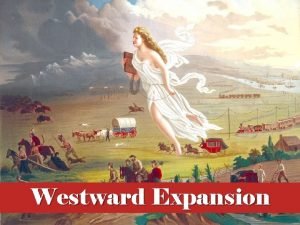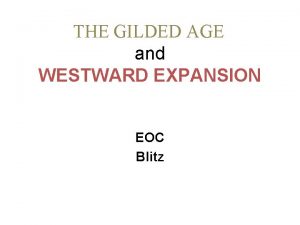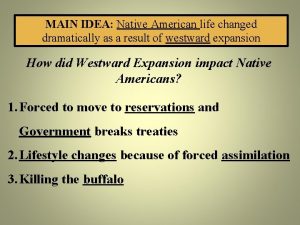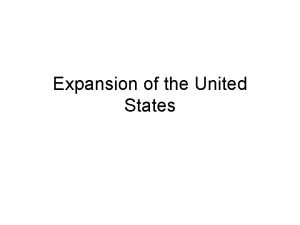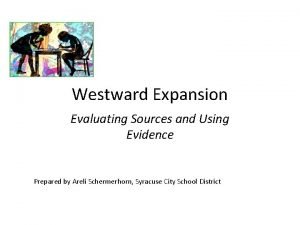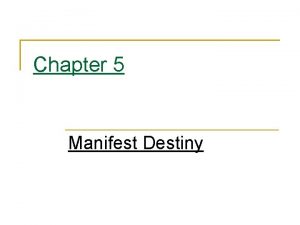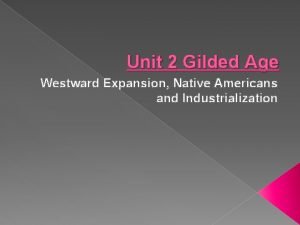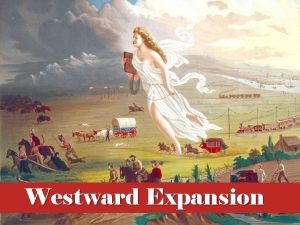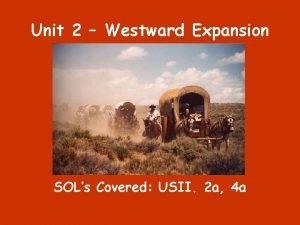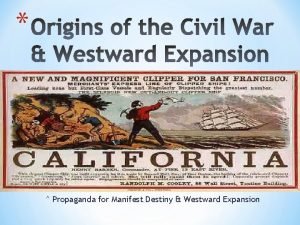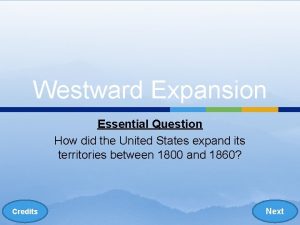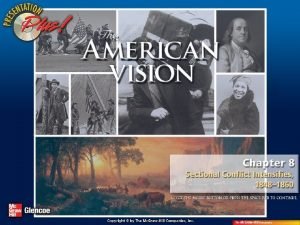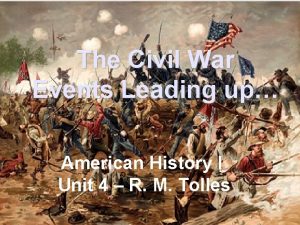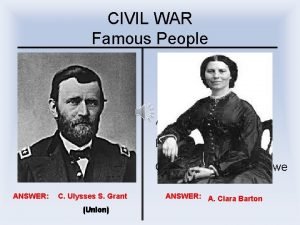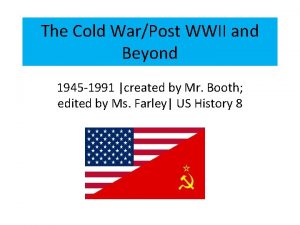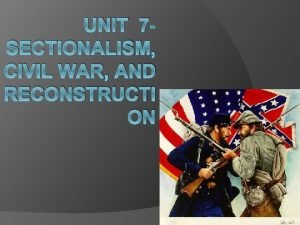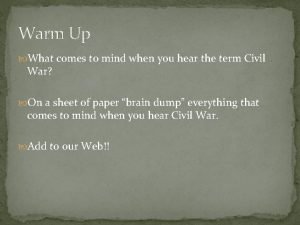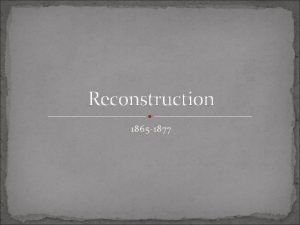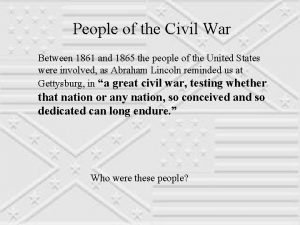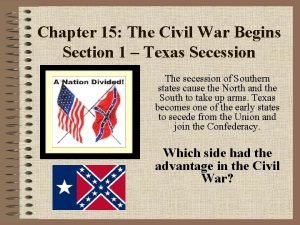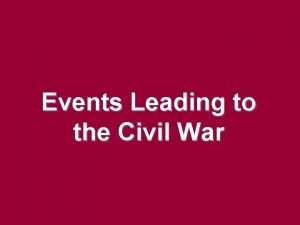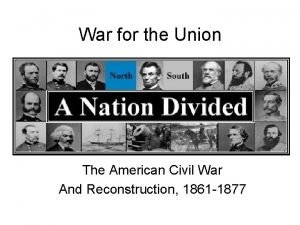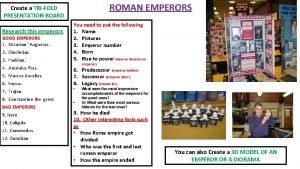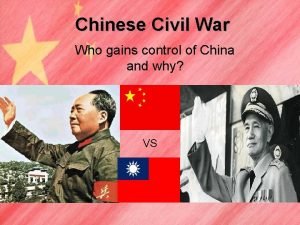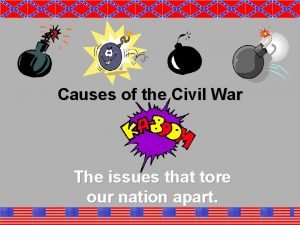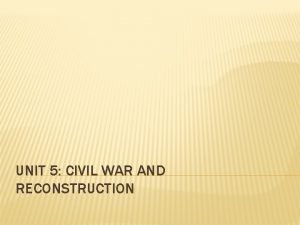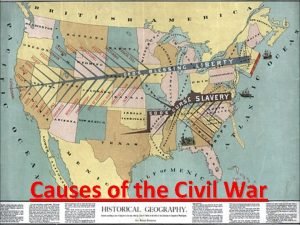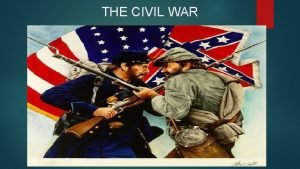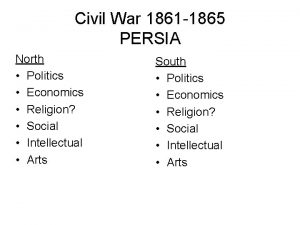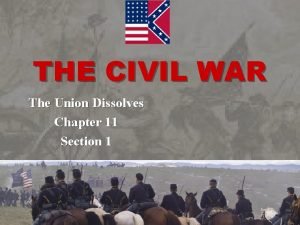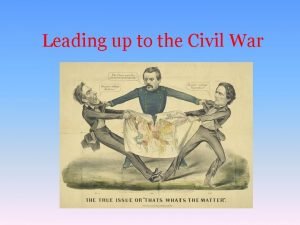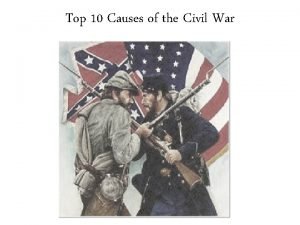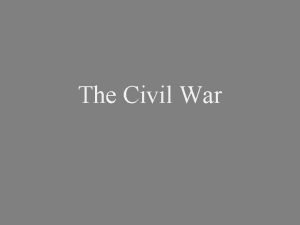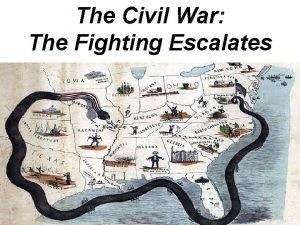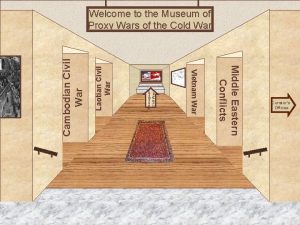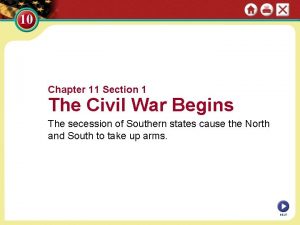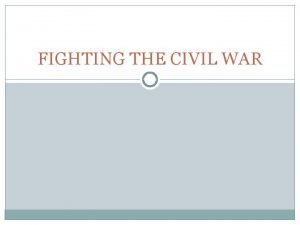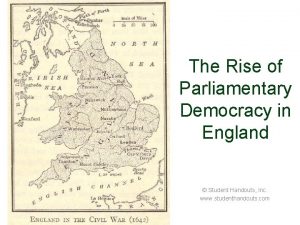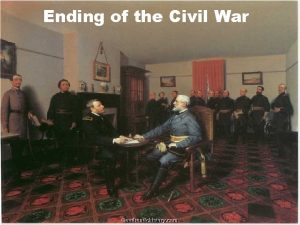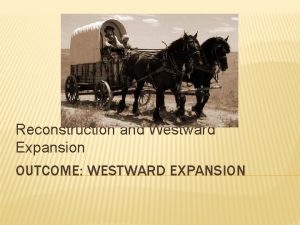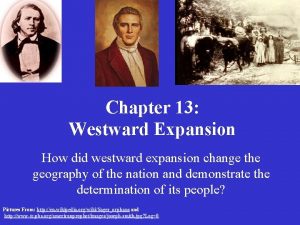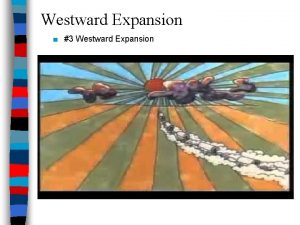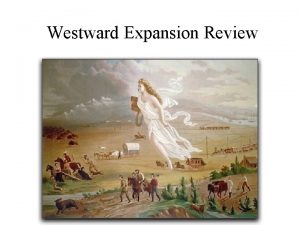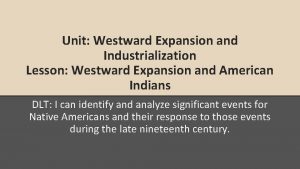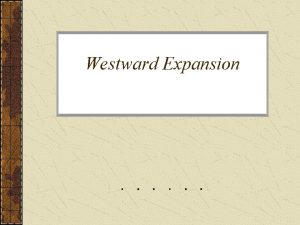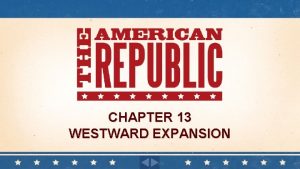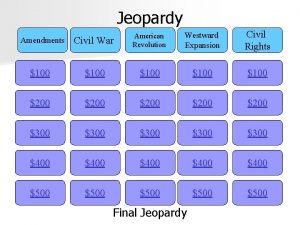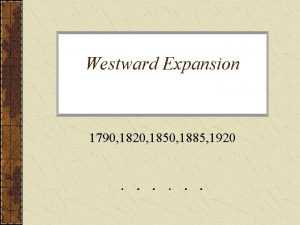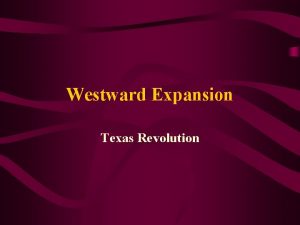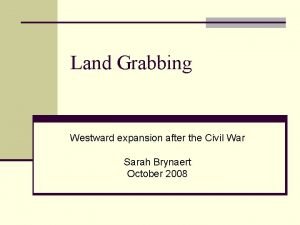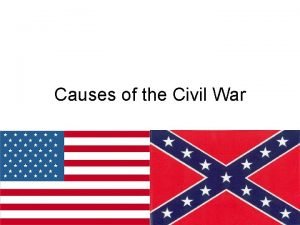Slavery Complicates Westward Expansion The Civil War Approaches









































![“In the gloomiest moment of the revolutionary war, I never had any [fears] equal “In the gloomiest moment of the revolutionary war, I never had any [fears] equal](https://slidetodoc.com/presentation_image_h2/9e0ac2696f5f6369e173b04f5a8b3db4/image-42.jpg)






















- Slides: 64

Slavery Complicates Westward Expansion The Civil War Approaches

Planner Take out your timeline. Across the top, copy the following questions: • How does the U. S. deal with sectional issues that arise from Westward expansion? • How does sectionalism flare into war? • States’ rights/nullification – What is the South’s true position on this? • What causes the Civil War?

Timeline Questions • How does the U. S. deal with sectional issues that arise from Westward expansion? • How does sectionalism flare into war? • States’ rights/nullification – What is the South’s true position? • What causes the Civil War?

Planner Copy and answer the following question after rereading page 398 and using the chart on 410: What was happening in the United States (in the early 1820 s-1860 s) that Americans as people and their views on the world were changing? Include examples of political and social reform in your answer.

In the last few units, we’ve learned about the changing worlds of North and South (and increase in sectionalism because of it) and massive Westward Expansion. The NATION was changing quickly. What was happening in the United States that Americans as people and their views on the world were changing? Read 398 and use the chart on 410 to answer. (Answer includes changes in America connected to the Second Great Awakening and Reform Units – connect to your learning from ELA)

Choose a partner 1. Planner 2. Take out your timelines and Missouri Compromise video notes. 3. Copy and answer: What happened during the Second Great Awakening and what impact did it have on American society?

Sectionalism During our North/South unit, we talked about reasons why sectionalism began to develop in the United States. What issues contributed to sectionalism between the North and South?

What issues lead to sectionalism? • Rapid expansion and industrialization • Economic problems – no national bank • Foreign competition • Congress begins passing protective tariffs in 1816

In response to increased conflict over slavery even after the Kansas-Nebraska Act for compromise, Abraham Lincoln said, “In my opinion, it will not cease until a crisis shall have been reached and passed. "A house divided against itself cannot stand. " I believe this government cannot endure, permanently, half slave and half free. I do not expect the Union to be dissolved; I do not expect the house to fall; but I do expect it will cease to be divided. It will become all one thing, or all the other. Either the opponents of slavery will arrest the further spread of it and place it where the public mind shall rest in the belief that it is in the course of ultimate extinction, or its advocates will push it forward till it shall become alike lawful in all the states, old as well as new, North as well as South.

“But, as it is, we have the wolf by the ears, and we can neither hold him, nor safely let him go. Justice is in one scale, and self-preservation in the other. ” - Jefferson to John Holmes, (discussing slavery and the Missouri question), April 22, 1820 Stop and Write: What was the “wolf by the ears” and how do you know?

What did Jefferson say? What did Lincoln say? Compare/contrast – how are the quotes similar/different?

• How does the U. S. deal with sectional issues that arise from Westward expansion? • How does sectionalism flare into war? • States’ rights/nullification – What is the South’s true position on this? • What causes the Civil War? • If Andrew Jackson were president, could he have stopped the Civil War?

Questions from the video 1. How did slavery complicate westward expansion and contribute to sectionalism? 2. SW – Map of U. S. in 1819: How had the U. S. changed by the time Missouri applied to be a state in 1819? 3. Why was Missouri rejected when they applied? 4. SW – What have we already learned about how slavery caused division within our country? 5. SW – What was the “wolf by the ears” and how do you know? 6. How does the Missouri Compromise get Missouri into the Union without upsetting the balance between free/slave states (short term)? 7. How does the Missouri Compromise plan for the settlement of the rest of America’s western territory (long term)? 8. SW – Does the Missouri Compromise line seem fair? Why does it stop being a valid long term solution?

Missouri’s Causing Problems The United States is all about Westward Expansion – MORE LAND! Between 1783 -1820, we added Alabama, Mississippi, Tennessee, Kentucky, and Louisiana. What’s the BIG deal about Missouri?

If Missouri is added to the Union: • Upset the free/slave state balance 11: 11 • Senate would contain a Southern majority

Quiz 1. Why was Missouri rejected when it applied for statehood? 2. Who wrote the Missouri Compromise? 3. What was the short term compromise to allow Missouri in the Union? 4. What was the long term compromise for Westward expansion? 5. What three ideas about slavery were included in the Constitution?

Quiz 1. Why was Missouri rejected when it applied for statehood? It would create an imbalance in the Senate which was 11: 11 free/slave state, and Southern states would pass laws protecting/expanding slavery. 2. Who wrote the Missouri Compromise? Henry Clay

3. What was the short term compromise to the let Missouri into the Union? The short term compromise was that Missouri and Maine would enter at the same time. Missouri as a slave state, and Maine as a free state.

4. What was the long term compromise for Westward expansion? Divide the remainder of the territory from the Louisiana Purchase at 36 30 N. All states north of that line will be free states (except Missouri). All states south will be slave states

Why doesn’t the Missouri Compromise last?

Slavery Polarizes America Polarize – to cause people to separate into opposing groups Slavery was always an issue for America. What was decided about slavery at the Constitutional Convention?

5. What three ideas about slavery were included in the Constitution? 1. Congress cannot do anything to ban the slave trade for 20 years. 2. 3/5 Compromise – slaves count as 3/5 in a state’s total population for representation in the House of Representatives. 3. Fugitive Slave Law – runaway slaves must be returned even when in a free state

Slavery Polarizes America Read 424 -426 beginning at New Western Lands and stopping at the Free Soil Party to complete the chart Abolitionists Moderates Slaveholders/Support ers

Goals for Active Reading: • How were American views on slavery polarized in the Antebellum period? • How did Henry Clay, Daniel Webster, and John C. Calhoun fit into these views? • What was the Compromise of 1850, why was it needed, and what were the effects?


Views on Slavery Abolitionists Slavery is morally wrong – evil Must be banned everywhere Moderates Slaveholders/ Supporters Extend Missouri Compromise Line to the Pacific Slavery needs to be allowed in every territory Use popular sovereignty in the territories Fugitive slaves must be returned

Wilmot Proviso Proposed by Representative David Wilmot (D-Representative Pennsylvania) - Proposed/passed by House for appropriations for the Mexican War IF slavery was banned in all territories gained from Mexico (1846) - Proposed/passed by House as to be part of the Treaty of Guadalupe Hidalgo – appropriate $ for Mexican Cession IF slavery was banned in all territories gained from Mexico (1848).

Compromise of 1850 1. Divided the remaining land in the Mexican Cession into the Utah Territory and New Mexico Territory – use popular sovereignty to decide slavery 2. Settles the border dispute between Texas and New Mexico 3. Allows California to enter as a free state 4. Bans the slave trade in Washington D. C. 5. Created strict Fugitive Slave Law of 1850

Sectionalism over slavery in the West was dividing the nation. The slavery question in all western lands was settled by the end of the Compromise of 1850. Why did sectionalism over slavery continue to increase?

What’s left to argue about? Why does tension over slavery worsen?

Compromise of 1850 True/False Explain: Both the North and the South were happy with the Compromise of 1850. With the Compromise of 1850, Congress had addressed slavery in all U. S. territories.


Copy and answer the following question: What made slavery a topic that Northerners talked about and cared about? Use what we learned yesterday and read page 430 to answer.

Kansas bled over the issue of slavery. Why was Kansas the setting of a civil war? Kansas-Nebraska Act popular sovereignty Border Ruffians abolitionist Jayhawkers Missouri Compromise John Brown Free State repeal Bleeding Kansas Stephen Douglas guerrilla warfare legitimate government

Learning Targets 4. I can describe Dred Scott v. Sandford decision (1857) and how it increased sectional tension. 8. I can connect the arguments at the Constitutional Convention to the issues between the Northern and Southern states in the Antebellum period (e. g. distribution of political power, rights of the individual, rights of states, election of the executive, and slavery).

1. Using your T 4, independently complete the Dred Scott Argument box (#5 on 16. 2) 2. When finished with independent work, share your T 4 with your group, updating your answer on 16. 2 Purpose: What evidence was provided that Dred Scott should be a free man? Be specific.

Dred Scott claimed that he should be free because his owner held him and his family as slaves in free states for years. Evidence: • 1834 – Lived in Illinois – slavery had always been banned in Northwest Territory • 1836 - lived at Fort Snelling north of Missouri Compromise line Daughter Eliza born north of Missouri Compromise line

Partner question: On the top of your Dred Scott T 4, answer the following question: How was slavery included in the Constitution and why did Northerners agree for those items to be included? Be specific

Slavery in the Constitution 1. Congress may not take action to ban the slave trade for 20 years 2. Fugitive Slave Law – (Article 4, Section 2. 3) – Slaves who run to free states are still property and must be returned to owners 3. 3/5 Compromise – slaves count as 3/5 of a person in a state’s total population for representation in the House of Representatives Included: 1. Southerners refused to ratify the Constitution without slavery included. Northerners wanted a country more. 2. Slavery had been naturally declining. Founding Fathers thought it would be much easier to end in 20 years.

After reading, you should be able to use the document to answer the following questions: 1. What question did the Supreme Court (S. C. ) say they were answering? 2. What did the S. C. say were the rights of African-Americans according to the Constitution? 3. What were African-Americans labeled if anyone in their family were ever slaves? 4. What act of Congress does the S. C. overturn with judicial review and why?

In the Dred Scott Case, the Supreme Court Decides: • African-Americans were not citizens (nor were they intended ever to be) who received rights according to the Constitution – this applies to all African-Americans who had any slave ancestor • Claimed whites were the dominant race • Claimed the Constitution, according to our Founding Fathers, intended for African-Americans to be “ordinary articles of merchandise” (property) • Claimed Congress did not have the right to outlaw slavery (only states can do that) – repeals the Missouri Compromise
![In the gloomiest moment of the revolutionary war I never had any fears equal “In the gloomiest moment of the revolutionary war, I never had any [fears] equal](https://slidetodoc.com/presentation_image_h2/9e0ac2696f5f6369e173b04f5a8b3db4/image-42.jpg)
“In the gloomiest moment of the revolutionary war, I never had any [fears] equal to what I feel from this source…We have a wolf by the ears, and we can neither hold him nor safely let him go. ” - Thomas Jefferson 1820 What does this mean? Give examples to support your answer.

“A house divided against itself cannot stand. I believe this government cannot endure permanently half slave and half free. I do not expect the Union to be dissolved—I do not expect the house to fall—but I do expect it will cease to be divided. It will become all one thing or all the other. ”

What did he say: Northern abolitionist Moderate: Southern Slaveholder:

Either the opponents of slavery, will arrest the further spread of it, and place it where the public mind shall rest in the belief that it is in the course of ultimate extinction; or its advocates will push it forward, till it shall become alike lawful in all the States, old as well as new -- North as well as South. Have we no tendency to the latter condition?

South Carolina • “A geographical line has been drawn across the Union, and all the States north of that line have united in the election of a man to the high office of President of the United States, whose opinions and purposes are hostile to slavery. He is to be entrusted with the administration of the common Government, because he has declared that "Government cannot endure permanently half slave, half free, " and that the public mind must rest in the belief that slavery is in the course of ultimate extinction. ”

States’ Rights? These ends it endeavored to accomplish by a Federal Government, in which each State was recognized as an equal, and had separate control over its own institutions. The right of property in slaves was recognized by giving to free persons distinct political rights, by giving them the right to represent, and burthening them with direct taxes for threefifths of their slaves; by authorizing the importation of slaves for twenty years; and by stipulating for the rendition of fugitives from labor.

As citizens and future voters, what lesson can be learned from this?

How do we elect a president in the United States?

What did the delegates at the Constitutional Convention discuss about the presidency? Worries? Election? Number? Purpose?

Election of 1860 The Democratic Party will split in 1860 over the issue of slavery. Northern Democrats will nominate Stephen Douglas Southern Democrats will nominate John Breckinridge

Popular Vote 39. 8% Electoral Votes 180 States Carried 17 Breckenridge S. Democrat 18. 1% 72 11 Douglas N. Democrat 29. 5% 12 1 John Bell Constitutional Union 12. 6% 39 3 Lincoln Republican




Reasons for Southern Secession Fall into three categories: Political Economic Social

When finished reviewing Myth 4, begin reviewing the Mississippi Secession Document. Goal: • Be able to explain why Southern states seceded. • Provide specific political, economic, and social examples for Southern secession.

Planners Answer the following questions according to the Declaration of Independence*: 1. What is the purpose of government? 2. Where does a government get its power? 3. When can people rebel? *Use the Preamble and Purpose of Government on page 590591

I can connect the arguments at the Constitutional Convention to the issues between the Northern and Southern states in the Antebellum period (e. g. distribution of political power, rights of the individual, rights of states, election of the executive, and slavery). Distribution of Political Power Rights of the Individual Rights of States Election of the Executive Slavery

Political Reasons for Secession POLITICAL • **States’ Rights: The United States was not looking out for Southern interests and rights. Southern states believed they had the right to leave the Union. ** • Lincoln’s Election

Cause of the Civil War-States’ Rights? Southern states believed they had the right to leave the Union and form an independent nation States may: • Alter or abolish a government that denies rights of citizens - Lincoln would deny citizen’s right to own slaves • Ignore federal laws on issues that are better decided by individual states • Lincoln’s Election

Economic Reasons ECONOMIC • 60% of Southern economy is cotton export • 4 million slaves • Billions in slave trading industry • North protects its economic interests but ignores the South. Examples:

SOCIAL Social Reasons • Rich Southerners breed fear among Yeomen and tenant farmers • Fear that freed blacks will be given equality • Fight for social status

True/False Explain 1. Southern states seceded because of states’ rights. 2. The Civil War was a war fought over slavery. 3. Abraham Lincoln believed Southern secession was unconstitutional.
 Jimmy fallon gadsden purchase
Jimmy fallon gadsden purchase Facts about manifest destiny
Facts about manifest destiny Gained voter support by helping immigrants find jobs.
Gained voter support by helping immigrants find jobs. Westward expansion vocabulary
Westward expansion vocabulary Assimilation westward expansion
Assimilation westward expansion Unit 3 rev. statehood and westward expansion
Unit 3 rev. statehood and westward expansion Westward expansion map
Westward expansion map How did westward expansion increase sectional tensions
How did westward expansion increase sectional tensions Westward expansion vocabulary words
Westward expansion vocabulary words Chapter 13 westward expansion
Chapter 13 westward expansion Unit 2 westward expansion vocabulary
Unit 2 westward expansion vocabulary Great plains westward expansion
Great plains westward expansion A trip westward question and answer
A trip westward question and answer Westward expansion
Westward expansion Westward expansion wagon
Westward expansion wagon Gilded age acrostic poem
Gilded age acrostic poem Effects of westward expansion
Effects of westward expansion Westward expansion thesis statement
Westward expansion thesis statement Westward expansion timeline
Westward expansion timeline Westward expansion lewis and clark
Westward expansion lewis and clark Westward expansion essential questions
Westward expansion essential questions Homeland security
Homeland security California gold rush advertisement
California gold rush advertisement Westward expansion clipart
Westward expansion clipart Lesson 1 slavery and western expansion
Lesson 1 slavery and western expansion Toward civil war lesson 3 secession and war
Toward civil war lesson 3 secession and war Why was the civil war the first modern war
Why was the civil war the first modern war Civil rights webquest
Civil rights webquest Image
Image Famous people in the civil war
Famous people in the civil war Vietnam war at home webquest answers
Vietnam war at home webquest answers Civil war and reconstruction achieve 3000 answer key
Civil war and reconstruction achieve 3000 answer key Civil war advantages and disadvantages chart
Civil war advantages and disadvantages chart English civil war mind map
English civil war mind map Civil war map activity
Civil war map activity English civil war timeline
English civil war timeline Aftershock beyond the civil war
Aftershock beyond the civil war Civil war 1861/1862
Civil war 1861/1862 Pablo picasso spanish civil war
Pablo picasso spanish civil war States rights
States rights Civil war thesis statement
Civil war thesis statement What events led to the civil war
What events led to the civil war Civil war and reconstruction study guide
Civil war and reconstruction study guide Civil war usa
Civil war usa Civil war trifold
Civil war trifold Who
Who What are the 3 main causes of the civil war
What are the 3 main causes of the civil war Civil war and reconstruction vocabulary
Civil war and reconstruction vocabulary Northwest ordinance lead to civil war
Northwest ordinance lead to civil war Confederate surrender day
Confederate surrender day Civil war basics
Civil war basics Civil war advantages and disadvantages chart
Civil war advantages and disadvantages chart Southern states civil war
Southern states civil war What led to the civil war
What led to the civil war Causes of the civil war
Causes of the civil war What led to civil war
What led to civil war The civil war the fighting escalates
The civil war the fighting escalates The furnace of civil war
The furnace of civil war The civil war
The civil war Viet cong flag
Viet cong flag Chapter 11 section 1
Chapter 11 section 1 Civil war union strategy
Civil war union strategy Causes of the civil war jeopardy
Causes of the civil war jeopardy Civil war dates
Civil war dates Civil war map sherman's march to the sea
Civil war map sherman's march to the sea

